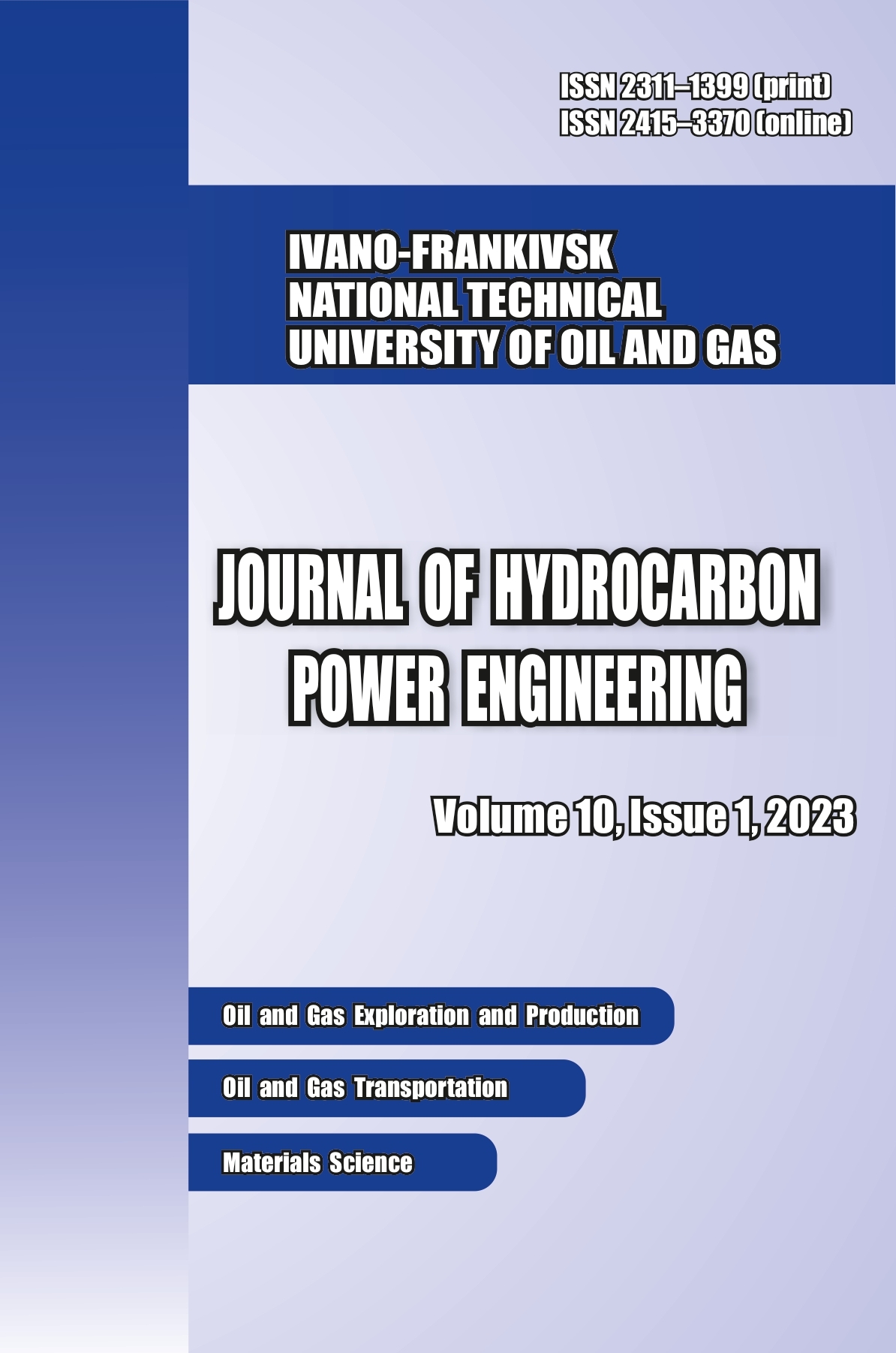Influence of electrolytic hydrogenation on stress-corrosion cracking of X70 steel and pipes of long-term exploited main gas pipeline
DOI:
https://doi.org/10.31471/2311-1399-2023-1(19)-15-24Keywords:
electrolytic hydrogenation, potentiometry, scanning electron microscopy, slow strain rate test, stress-corrosion cracking.Abstract
Cathodic polarization, which is used in the complex anti-corrosion protection of main gas pipelines to reduce the corrosion rate to a technically acceptable level, causes the decomposition of the soil electrolyte with the recovery of hydrogen, and its penetration into the steel under the action of tensile stresses contributes to the change in the mechanical properties of the pipes and resistance to stress-corrosion cracking. Comprehensive studies were conducted, and the effect of electrolytic hydrogen penetration on stress-corrosion cracking of X70 steel specimens made from a steel sheet and pipe of a long-term main gas pipeline in a model soil electrolyte NS4 under cathodic polarization in the range of potentials from -0.75 to -1.05 V was determined. The following methods were used in the work: slow strain rate tests, potentiometry, voltammetry, electrolytic hydrogenation, the method of scanning electron microscopy, and optical microscopy. It was established that for both types of specimens, the concentration of hydrogen penetrating into the steel during cathodic polarization increases non-monotonically, with a potential shift from -0.75 to -1.05 V. It is noted that the hydrogenation of specimens of steel under investigation begins at a lower protective potential than steel sheet specimens: -0.95 and -1.05 V, respectively. The concentration of hydrogen diffusing into steel for specimens from a sheet changes in the range 0 0 0.057 mol/m3, for specimens from an operated pipe – 0 0.019 0.024 mol/m3. As a result of the course of the hydrogen diffusion process, there is an increase in the susceptibility to stress-corrosion cracking of specimens from the operated pipe compared to specimens from sheet steel. The coefficient of susceptibility to stress-corrosion cracking KS for the steel sheet changes less intensively than for the specimens from the operated pipe: 1.06 1.06 1.18 and 1.25 1.35 1.53, respectively. Therefore, it was established that specimens made from long-term operating under complex anti-corrosion protection of the main gas pipeline have an increased susceptibility to electrolytic hydrogenation compared to specimens made of steel sheet, and as a result, an increased susceptibility to stress-corrosion cracking.
Downloads
References
Nyrkova, L & Osadchuk, S 2023, ‘Stress-corrosion cracking of the steels of main gas pipeline: assessment and prevention’, Naukova dumka, 216 p. https://doi.org/10.15407/978-966-00-1845-7 [2] Nyrkova, L 2020, ‘Stress-corrosion cracking of pipe steel under complex influence of factors’, Engineering Failure Analysis, vol. 116, 104757. https://doi.org/10.1016/ j.engfailanal.2020.104757 [3] Laureys, A, Depraetere, R, Cauwels, M, Depover, T, Hertelé, S & Verbeken, K 2022, ‘Use of existing steel pipeline infrastructure for gaseous hydrogen storage and transport: A review of factors affecting hydrogen induced degradation’, Journal of Natural Gas Science and Engineering, 104534. https://doi.org/10.1016/j.jngse.2022.104534 [4] Shirband, Z, Shishesaz, MR & Ashrafi, A 2011, ‘Hydrogen degradation of steels and its related parameters, a review’, Phase Transitions, vol. 84, iss. 11–12, pp. 924–943. https://doi.org/10.1080/01411594.2011.561774
Rybakov, AA, Goncharenko, LV, Filipchuk, TN, Lokhman, IV & Burak, IZ 2014, ‘Reasons of stress corrosion failure of erection girth joint of main gas pipeline’, The Paton Welding Journal, no. 3, pp. 49–52. https://doi.org/10.15407/ tpwj2014.03.09
Polyakov, SG & Rybakov, AA 2009, ‘The main mechanisms of stress corrosion cracking in natural gas trunk lines’, Strength of Materials, no. 41, pp. 456–463. https://doi.org/10.1007/s11223-009-9164-x [7] Nyrkova, L, Rybakov, A, Goncharenko, L, Osadchuk, S & Kharchenko, Yu 2023, ‘Analysis of the causes of fracture of the main gas pipeline’, Zaštita materijala, vol. 64, no. 2, pp. 177–189. https://doi.org/10.5937/ zasmat2302177N
Lu, WC & Wu, JK 1996, ‘The influence of microstructure on hydrogen transport in carbon steels’, Corrosion Science, vol. 38, pp. 239–245. https://doi.org/10.1016/0010-938X(96)00109-6
Dey, S, Mandhyan, AK, Sondhi, SK & Chattoraj, I 2006, ‘Hydrogen entry into pipeline steel under freely corroding conditions in two corroding media’, Corrosion Science, vol. 48, pp. 2676–2688. https://doi.org/10.1016/ j.corsci.2005.10.003
Lu, BT, Luo, JL, Norton, PR & Ma, HY 2009, ‘Effects of dissolved hydrogen and elastic and plastic deformation on active dissolution of pipeline steel in anaerobic groundwater of near-neutral Ph’, Acta Materialia, vol. 57, pp. 41–49.
Meng, GZ, Zhang, C & Cheng, YF 2008, ‘Effects of corrosion product deposit on the subsequent cathodic and anodic reactions of X-70 steel in near-neutral pH solution’, Corrosion Science, vol. 50, pp. 3116–3122. https://doi.org/10.1016/j.corsci.2008.08.026
Nykyforchyn, HM 2011, ‘Specific features of hydrogen-induced corrosion degradation of steels of gas and oil pipelines and oil storage reservoirs’, Materials Science, vol. 47, pp. 127–136. https://doi.org/10.1007/s11003-011-9390-9 [13] Kryzhanivskyi, YeI & Nykyforchyn, HM 2013, ‘Corrosion-hydrogen degradation of gas transport systems’, Scientific Notes, vol. 41, iss. 1, pp. 148–153. [14] Paton, BЕ, Semenov, SE, Rybakov, АА, Vasilenko, SK & Vasilyuk, VM 2000, ‘Ageing and procedure of evaluation of the state of metal of the main pipelines in service’, The Paton welding journal, no. 7, pp. 2–20.
Semenov, SE, Rybakov, AA, Kirian VI, Filipchuk, TN, Goncharenko, LV, Vasilyuk, VM & Vlasyuk, FS 2001, ‘Experimental evaluation of the state of metal of long-serviced welded oil pipelines’, The Paton welding journal, no. 5, pp. 17–21.
Semyonov, SE, Rybakov, AA, Goncharenko, LV, Filipchuk, TN, Drogomiretsky, MN & Pedko, BI 2003, ‘Evaluation of condition of metal of welded pipes of long-operated gas pipelines’, The Paton welding journal, no. 4, pp. 2–6.
Nyrkova, LI, Goncharenko, LV, Rybakov, AO, Osadchuk, SO, Klymenko, AV, & Kharchenko, YuO 2023, ‘Investigation of welded joints of long-term operated gas pipeline controllable rolled X70 steel’, FME Transactions, vol. 51, iss. 1, pp. 71–80. https://doi.org/10.5937/fme2301071N [18] Rahman, KMM, Qin, W, Szpunar, JA, Kozinski, J, Song, M & Zhu, N 2021, ‘New insight into the role of inclusions in hydrogen-induced degradation of fracture toughness: three-dimensional imaging and modeling’, Philosophical Magazine, vol. 101, iss. 8, pp. 976–996. https://doi.org/10.1080/14786435.2021.1876267
Peng, Z, Cao, C, Huang, F, Wang, L, Xue, Z & Liu, J 2023, ‘Effect of slow strain rates on the hydrogen migration and different crack propagation modes in pipeline steel’, Steel research international, First published: 11 March. https://doi.org/10.1002/srin.202300070
Kryzhanivskyi, YeI 2014, ‘Degradation of materials of oil and gas facilities in long-term operation and ways to ensure their operability’, Development of deposits: Collection of sci. works, vol. 8, pp. 241–253.
Krechkovska, HV, Tsyrulnyk, OT & Student, OZ 2019, ‘In-Service Degradation of Mechanical Characteristics of Pipe Steels in Gas Mains’, Strength Materials, vol. 51, pp. 406–417. https://doi.org/10.1007/s11223-019-00087-4
Zvirko, OI 2021, ‘In-Service Degradation of Structural Steels (A Survey)’, Materials Sciences, vol. 57, pp. 319–330. https://doi.org/10.1007/s11003-021-00547-w
Maruschak, PO, Danyliuk, IM, Bishchak, RT et al. 2014, ‘Low temperature impact toughness of the main gas pipeline steel after long-term degradation’, Central European Journal of Engineering, vol. 4, pp. 408–415. https://doi.org/10.2478/s13531-013-0178-6
Сheng, YF 2013, Stress corrosion of pipeline / edited by R. Winston. New Jersey, John Wiley & Sons Inc., 288 p.
Technical Specification 14-3-995–81. Expanded electric-welded longitudinally welded steel pipes with a diameter of 1420 mm from X70 grade steel.
R. Antunes de Sena, І. Napoleão Bastos, G. Mendes Platt, 2012. Theoretical and Experimental Aspects of the Corrosivity of Simulated Soil Solutions, International Scholarly Research Notices. Article ID 103715, 6 pages. [27] GOST R 9.915–2010. Unified system of corrosion and ageing protection. Metals, alloys, coatings, products. Test methods of hydrogen embrittlement. Moscow, Standartinform Publ., 2011, 31 p. [in Russian] [28] GOST 5640-68 Steel. Metallographic method for determination of microstructure of shedts and bands. [in Russian] [29] DSTU 8972:2019 Steel and alloys. Methods for detection and determination of grain size. [in Ukrainian] [30] Nyrkova, LI, Klymenko, AV, Osadchuk, SO & Kovalenko, SYu 2023, ‘Comparative investigation of electrolytic hydrogenation of pipe assortment steel under cathodic polarization’, International Journal of Hydrogen Energy, Available online 12 July 2023. https://doi.org/10.1016/j.ijhydene.2023.06.316
Liu, ZY, Li, XG & Cheng, YF 2010, ‘In-situ characterization of the electrochemistry of grain and grain boundary of anX70 steel in a near-neutral pH solution’, Electrochem. Commun, vol. 12. p. 936–938. https://doi.org/10.1016/j.elecom.2010.04.025
Downloads
Published
How to Cite
Issue
Section
License
Copyright Notice


1.png)





1.png)
